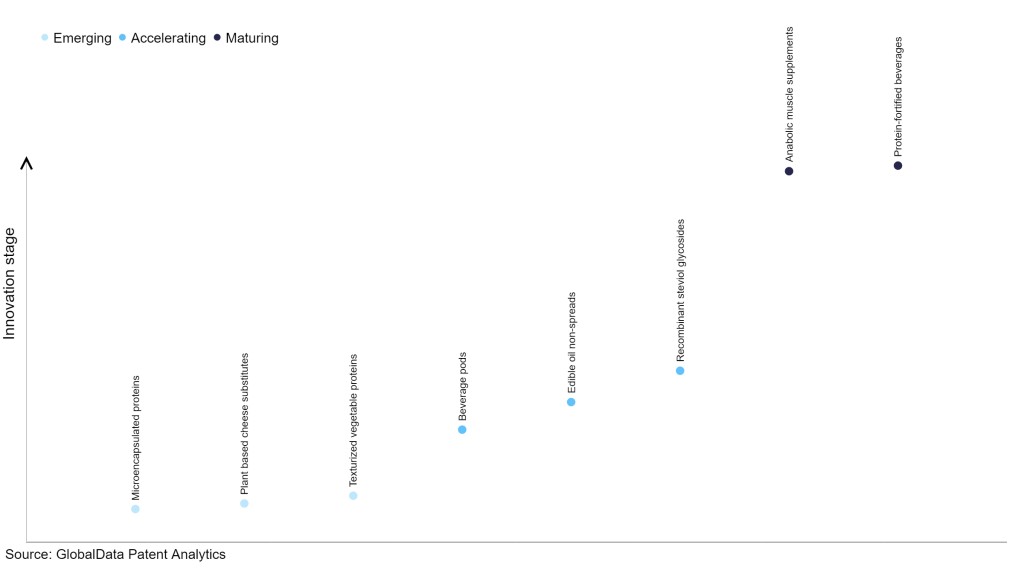The consumer industry continues to be a hotbed of patent innovation. Activity is driven by convenience, and health and wellness, and the growing importance of technologies such as personalized nutrition, 3D food printer, and food safety and transparency. In the last three years alone, there have been over 52,000 patents filed and granted in the consumer industry, according to GlobalData’s report on Innovation in consumer: low glycemic index foods. Buy the report here.
However, not all innovations are equal and nor do they follow a constant upward trend. Instead, their evolution takes the form of an S-shaped curve that reflects their typical lifecycle from early emergence to accelerating adoption, before finally stabilizing and reaching maturity.
Identifying where a particular innovation is on this journey, especially those that are in the emerging and accelerating stages, is essential for understanding their current level of adoption and the likely future trajectory and impact they will have.
30+ innovations will shape the consumer industry
According to GlobalData’s Technology Foresights, which plots the S-curve for the consumer industry using innovation intensity models built on over 12,000 patents, there are 30+ innovation areas that will shape the future of the industry.
Within the emerging innovation stage, microencapsulated proteins, plant based cheese substitutes, and texturized vegetable proteins are disruptive technologies that are in the early stages of application and should be tracked closely. Beverage pods, edible oil non-spreads and recombinant steviol glycosides are some of the accelerating innovation areas, where adoption has been steadily increasing. Among maturing innovation areas are anabolic muscle supplements and protein-fortified beverages, which are now well established in the industry.
Innovation S-curve for the consumer industry

Low glycemic index foods is a key innovation area in consumer
Foods having a GI score below 55 are termed low-GI foods. These foods contain carbohydrates that break down slower than high-GI foods. As such, low-GI foods are highly beneficial for consumers having high blood sugar levels as they can slow down a person’s rise in sugar levels.
GlobalData’s analysis also uncovers the companies at the forefront of each innovation area and assesses the potential reach and impact of their patenting activity across different applications and geographies. According to GlobalData, there are 1390+ companies, spanning technology vendors, established consumer companies, and up-and-coming start-ups engaged in the development and application of low glycemic index foods.
Key players in low glycemic index foods – a disruptive innovation in the consumer industry
‘Application diversity’ measures the number of applications identified for each patent. It broadly splits companies into either ‘niche’ or ‘diversified’ innovators.
‘Geographic reach’ refers to the number of countries each patent is registered in. It reflects the breadth of geographic application intended, ranging from ‘global’ to ‘local’.
Patent volumes related to low glycemic index foods
Source: GlobalData Patent Analytics
Nestle is the leading patent filer in low glycemic food index. Some other key patent filers in low glycemic food index include Danone, DSM-Firmenich, Abbott Laboratories, and Kotobuki Realty. Recently, Danone added two low-GI milk formulas to its newly launched healthy ageing brand Ganmai, in China. The launches, namely Ganmai XinRuiLi senior goat milk powder and Ganmai MianYuLi senior milk powder, target consumers aged 40 and above.
In terms of application diversity, Nufarm leads the pack, with mondoBIOTECH and Valbiotis in second and third positions, respectively. By means of geographic reach, Alcresta Therapeutics holds the top position, followed by Amazentis and Nufarm.
In the coming years, low glycemic index foods will gain the attention of consumers who suffer from medical conditions such as high blood pressure and cannot rely on high glycemic index foods. Food manufacturers should continue to launch new products across categories to capture a wider consumer base.
To further understand the key themes and technologies disrupting the consumer industry, access GlobalData’s latest thematic research report on Consumer.
Data Insights
From

The gold standard of business intelligence.
Blending expert knowledge with cutting-edge technology, GlobalData’s unrivalled proprietary data will enable you to decode what’s happening in your market. You can make better informed decisions and gain a future-proof advantage over your competitors.



